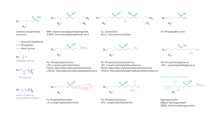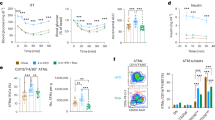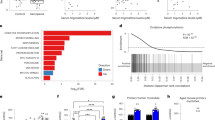Abstract
Insulin receptor substrate (IRS)-1 and IRS-2 have dominant roles in the action of insulin1, but other substrates of the insulin receptor kinase, such as Gab1, c-Cbl, SH2-B and APS, are also of physiological relevance2,3,4,5. Although the protein downstream of tyrosine kinases-1 (Dok1) is known to function as a multisite adapter molecule in insulin signaling6,7,8, its role in energy homeostasis has remained unclear. Here we show that Dok1 regulates adiposity. Expression of Dok1 in white adipose tissue was markedly increased in mice fed a high-fat diet, whereas adipocytes lacking this adapter were smaller and showed a reduced hypertrophic response to this dietary manipulation. Dok1-deficient mice were leaner and showed improved glucose tolerance and insulin sensitivity compared with wild-type mice. Embryonic fibroblasts from Dok1-deficient mice were impaired in adipogenic differentiation, and this defect was accompanied by an increased activity of the protein kinase ERK and a consequent increase in the phosphorylation of peroxisome proliferator–activated receptor (PPAR)-γ on Ser112. Mutation of this negative regulatory site for the transactivation activity of PPAR-γ blocked development of the lean phenotype caused by Dok1 ablation. These results indicate that Dok1 promotes adipocyte hypertrophy by counteracting the inhibitory effect of ERK on PPAR-γ and may thus confer predisposition to diet-induced obesity.
This is a preview of subscription content, access via your institution
Access options
Subscribe to this journal
Receive 12 print issues and online access
$209.00 per year
only $17.42 per issue
Buy this article
- Purchase on Springer Link
- Instant access to full article PDF
Prices may be subject to local taxes which are calculated during checkout




Similar content being viewed by others
Change history
23 January 2008
In the version of this article initially published online, the second sentence of the fifth paragraph of the main text referred to "Emr1 (also known as F4180).” This should read "Emr1 (also known as F4/80).” The error has been corrected for all versions of the article.
References
White, M.F. Insulin signaling in health and disease. Science 302, 1710–1711 (2003).
Minami, A. et al. Increased insulin sensitivity and hypoinsulinemia in APS knockout mice. Diabetes 52, 2657–2665 (2003).
Duan, C., Yang, H., White, M.F. & Rui, L. Disruption of the SH2-B gene causes age-dependent insulin resistance and glucose intolerance. Mol. Cell. Biol. 24, 7435–7443 (2004).
Molero, J.C. et al. c-Cbl–deficient mice have reduced adiposity, higher energy expenditure and improved peripheral insulin action. J. Clin. Invest. 114, 1326–1333 (2004).
Bard-Chapeau, E.A. et al. Deletion of Gab1 in the liver leads to enhanced glucose tolerance and improved hepatic insulin action. Nat. Med. 11, 567–571 (2005).
Hosomi, Y. et al. Characterization of a 60-kilodalton substrate of the insulin receptor kinase. J. Biol. Chem. 269, 11498–11502 (1994).
Carpino, N. et al. p62dok: a constitutively tyrosine-phosphorylated, GAP-associated protein in chronic myelogenous leukemia progenitor cells. Cell 88, 197–204 (1997).
Yamanashi, Y. & Baltimore, D. Identification of the Abl- and rasGAP-associated 62-kDa protein as a docking protein, Dok. Cell 88, 205–211 (1997).
Yamanashi, Y. et al. Role of the rasGAP-associated docking protein p62(dok) in negative regulation of B cell receptor-mediated signaling. Genes Dev. 14, 11–16 (2000).
Di Cristofano, A. et al. p62(dok), a negative regulator of Ras and mitogen-activated protein kinase (MAPK) activity, opposes leukemogenesis by p210(bcr-abl). J. Exp. Med. 194, 275–284 (2001).
Wick, M.J., Dong, L.Q., Hu, D., Langlais, P. & Liu, F. Insulin receptor–mediated p62dok tyrosine phosphorylation at residues 362 and 398 plays distinct roles for binding GTPase-activating protein and Nck and is essential for inhibiting insulin-stimulated activation of Ras and Akt. J. Biol. Chem. 276, 42843–42850 (2001).
Noguchi, T. et al. Tyrosine phosphorylation of p62(Dok) induced by cell adhesion and insulin: possible role in cell migration. EMBO J. 18, 1748–1760 (1999).
Hosooka, T. et al. Inhibition of the motility and growth of B16F10 mouse melanoma cells by dominant negative mutants of Dok-1. Mol. Cell. Biol. 21, 5437–5446 (2001).
Rosen, E.D. & Spiegelman, B.M. Molecular regulation of adipogenesis. Annu. Rev. Cell Dev. Biol. 16, 145–171 (2000).
Desvergne, B., Michalik, L. & Wahli, W. Transcriptional regulation of metabolism. Physiol. Rev. 86, 465–514 (2006).
Shinohara, H. et al. Dok-1 and Dok-2 are negative regulators of lipopolysaccharide-induced signaling. J. Exp. Med. 201, 333–339 (2005).
Kubota, N. et al. PPAR-γ mediates high-fat diet-induced adipocyte hypertrophy and insulin resistance. Mol. Cell 4, 597–609 (1999).
Miles, P.D., Barak, Y., He, W., Evans, R.M. & Olefsky, J.M. Improved insulin-sensitivity in mice heterozygous for PPAR-γ deficiency. J. Clin. Invest. 105, 287–292 (2000).
Koutnikova, H. et al. Compensation by the muscle limits the metabolic consequences of lipodystrophy in PPAR-γ hypomorphic mice. Proc. Natl. Acad. Sci. USA 100, 14457–14462 (2003).
He, W. et al. Adipose-specific peroxisome proliferator–activated receptor γ knockout causes insulin resistance in fat and liver but not in muscle. Proc. Natl. Acad. Sci. USA 100, 15712–15717 (2003).
Jones, J.R. et al. Deletion of PPAR-γ in adipose tissues of mice protects against high fat diet-induced obesity and insulin resistance. Proc. Natl. Acad. Sci. USA 102, 6207–6212 (2005).
Hu, E., Kim, J.B., Sarraf, P. & Spiegelman, B.M. Inhibition of adipogenesis through MAP kinase-mediated phosphorylation of PPAR-γ. Science 274, 2100–2103 (1996).
Adams, M., Reginato, M.J., Shao, D., Lazar, M.A. & Chatterjee, V.K. Transcriptional activation by peroxisome proliferator–activated receptor γ is inhibited by phosphorylation at a consensus mitogen-activated protein kinase site. J. Biol. Chem. 272, 5128–5132 (1997).
Camp, H.S. & Tafuri, S.R. Regulation of peroxisome proliferator–activated receptor γ activity by mitogen-activated protein kinase. J. Biol. Chem. 272, 10811–10816 (1997).
Shao, D. et al. Interdomain communication regulating ligand binding by PPAR-γ. Nature 396, 377–380 (1998).
Rangwala, S.M. et al. Genetic modulation of PPAR-γ phosphorylation regulates insulin sensitivity. Dev. Cell 5, 657–663 (2003).
Cock, T.A., Houten, S.M. & Auwerx, J. Peroxisome proliferator–activated receptor-γ: too much of a good thing causes harm. EMBO Rep. 5, 142–147 (2004).
Bluher, M. et al. Adipose tissue selective insulin receptor knockout protects against obesity and obesity-related glucose intolerance. Dev. Cell 3, 25–38 (2002).
Leitner, J.W., Kline, T., Carel, K., Goalstone, M. & Draznin, B. Hyperinsulinemia potentiates activation of p21Ras by growth factors. Endocrinology 138, 2211–2214 (1997).
Sakai, T. et al. Skp2 controls adipocyte proliferation during the development of obesity. J. Biol. Chem. 282, 2038–2046 (2007).
Acknowledgements
T.H. performed most of the experiments and data analysis and wrote the manuscript. T. Noguchi supervised the study and wrote the manuscript. K.K. performed hyperinsulinemic-euglycemic clamp studies. T. Nakamura and H.S. contributed to the measurement of adipocyte size and number. H.I. and W.O. contributed to the fractionation of adipose tissue. K. Tobimatsu, K. Takazawa and M.S. assisted with in vitro biochemical analyses. Y.M. and R.H. assisted with real-time quantitative RT-PCR analysis. T.Y. assisted with analysis of metabolic parameters. M.A.L. and Y.Y. contributed to the generation of mice used in this study and reviewed the manuscript. M.K. directed the project as a principal investigator and reviewed the manuscript.
Author information
Authors and Affiliations
Contributions
This work was supported by grants from the Ministry of Education, Culture, Sports, Science and Technology of Japan (MEXT) to M.K. and T. Noguchi; a grant for the Twenty-first Century Center for Excellence Program 'Center of Excellence for Signal Transduction Disease: Diabetes Mellitus as Model' from MEXT to M.K.; a grant for the Cooperative Link of Unique Science and Technology for Economy Revitalization from MEXT to M.K.; a Grant-in-Aid for Creative Scientific Research to M.K.; and US National Institutes of Health grant DK49780 to M.A.L. We thank Takeda Pharmaceutical for providing pioglitazone, Y. Tamori (Kobe University) for providing antibodies to PPAR-γ and an adenovirus vector encoding mouse Pparg, T. Satoh (Kobe University) for a GST fusion protein containing the Ras binding domain of c-Raf-1, K. Nakao (RIKEN Center for Developmental Biology) for generating mouse embroyos by in vitro fertilization and S. Hama for technical assistance.
Corresponding author
Supplementary information
Supplementary Text and Figures
Supplementary Figs. 1–7, Supplementary Table 1 and Supplementary Methods (PDF 1014 kb)
Rights and permissions
About this article
Cite this article
Hosooka, T., Noguchi, T., Kotani, K. et al. Dok1 mediates high-fat diet–induced adipocyte hypertrophy and obesity through modulation of PPAR-γ phosphorylation. Nat Med 14, 188–193 (2008). https://doi.org/10.1038/nm1706
Received:
Accepted:
Published:
Issue Date:
DOI: https://doi.org/10.1038/nm1706
This article is cited by
-
A gut microbial metabolite of linoleic acid ameliorates liver fibrosis by inhibiting TGF-β signaling in hepatic stellate cells
Scientific Reports (2023)
-
Developmental programming of appetite and growth in male rats increases hypothalamic serotonin (5-HT)5A receptor expression and sensitivity
International Journal of Obesity (2020)
-
Metformin induces lipogenic differentiation in myofibroblasts to reverse lung fibrosis
Nature Communications (2019)
-
Reintroducing testosterone in the db/db mouse partially restores normal glucose metabolism and insulin resistance in a leptin-independent manner
BMC Endocrine Disorders (2018)
-
Peroxisome Proliferator-Activated Receptor gamma negatively regulates liver regeneration after partial hepatectomy via the HGF/c-Met/ERK1/2 pathways
Scientific Reports (2018)



